 Spinning-wing decoys are no longer a novelty among duck hunters, who understand how and why they attract ducks to decoy spreads.
Spinning-wing decoys are no longer a novelty among duck hunters, who understand how and why they attract ducks to decoy spreads.
There’s no counting the times duck hunters sit in a blind, anxiously awaiting legal shooting hours, when they are reminded to be safe, followed quickly by, “And remember, don’t shoot the Mojo.”
After all, nobody wants to ruin the magic with a misguided blast of No. 2 steel shot.
“It ain’t magic if it ain’t a Mojo,” said Terry Denmon of Monroe, laughing while repeating the popular marketing slogan of Mojo Outdoors’ spinning-wing decoys. Denmon helped found Huntwise Inc., the Louisiana company that manufactures them, almost 20 years ago. Today, the question isn’t whether you have a Mojo in your spread, but how many and what kind.
“We struggled what to call the first decoys,” Denmon said.
“My dad used to have a crazy, motorized contraption on our family farm he called the Mojo, so that’s what we picked. Later, my engineering-firm folks developed a marketing strategy for the decoys. The head of the department walked in one day and she asked me if I even knew what Mojo meant. I didn’t really. She told me I’m the luckiest son of a gun in the world. I had basically named it, “Magic Mallard.” It couldn’t have been any better.”

Mojo has been magic in the marketplace and the decoy spread, so potent early on that the only sporting goods dealer that had limited production models, Simmons, in Bastrop, sold them one per customer in a brown paper bag; hunters had to come get it right before closing time so nobody else would see them. Denmon said the standing joke was that hunters were tossing expensive Benelli shotguns into the beds of their pickup trucks to make room to lock up their Mojos in the cab.
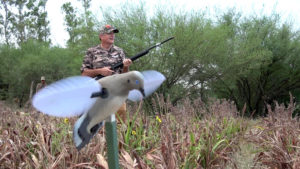
To date, more than 4 million spinning-wing decoys have been sold by Mojo. There’s a full line of duck species, plus doves and turkeys. It might be surprising, but dove decoys are the highest-selling model by species. There are more duck decoys sold overall, but there are numerous species: mallard, wigeons, pintail, teal, etc. The use of turkey Mojo decoys is also growing. Denmon said an exciting new development is about to enter production for the 2021 season.
Mojo has evolved from clanky, rough-running, awkward decoys that someone else had designed to smooth-operating, high-tech duck attractors that show the breeding of Denmon’s engineering touch.
Migrating ducks have begun to catch on, but smart hunters are figuring out how to stay one step ahead.
“Some hunters feel like Mojos are flaring ducks,” Denmon said. “They still work. Ducks are still naturally attracted to spinning-wing decoys. They just don’t always try to land on top of them every time like they did a few years ago. That’s where hunters have to adjust. It’s my belief that the Mojo decoys still work as good as they ever did at attracting ducks, but the flashing wings have made the ducks more leery up close. The way we counter that is to keep moving the Mojo further from the center of the actual killing hole as that happens.
“The best tip I can give hunters is to not turn it off, but to move it as the season progresses. The rule of thumb is put it in the middle of the decoys early in the season, near the edge of the spread middle of the season and then 100 yards away in a bush if you have to late in the season. Heck, we’ve even put it on dry ground out behind the blind. It still attracts ducks. Use it to get ducks close, then rely on your other decoys and calling skills to get the birds in.”
To understand that reasoning, it’s good to have a solid understanding of what makes spinning-wing decoys work in the first place.
“People should always have at least one spinning-wing decoy; I don’t say that just because we sell them,” Denmon said. “The motion of properly functioning, spinning-wing decoys gets ducks’ attention from a long way away. If you hunt, you know that sometimes, you can be walking out in the decoys and ducks continue to come right toward the spread but flare off 100 yards away when they see that there’s a man out there making that motion instead of other ducks.
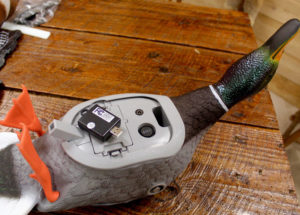
“Spinning wings give off a strobe affect. Ducks see it even before we see them. Speed is key. The wings have to spin fast to give off that strobe, at least 400 RPM or faster. The key is for the Mojo to get their attention, then the rest of the spread and calling gets them in range.”
Denmon said not to turn off a Mojo while hunting to save the battery, because there are no telling how many ducks are so high and far that may miss your spread because they don’t see the strobe. They can’t see it if you don’t have it on.
The longer you practice with Mojos, the more you learn and understand, Denmon said. One thing that hunters have picked up on is that multiple Mojos get the best reaction from new ducks, like ones coming in after a cold front. The first day, he said, they come to it like a magnet. The second day is pretty good; by the third day, they’re leery. By the fourth, you may need to take up golf until another front brings in new birds.
“Weather is important when using a Mojo,” he said. “When there is a real low cloud ceiling, birds get scared off by the motion, because by the time they are seeing it, they are right up on it. A cold, bluebird day after a front is a great time to have all the Mojo decoys you can spinning.”
The Mojo is a natural for Denmon’s favorite type of hunting.
“The thing that moves me the most is watching big mallards come down through the flooded timber and head for the decoy spread,” he said. “To me, duck hunting is all about decoying ducks. Even if we’ve got ducks working, and they aren’t working like we expect, we’ll hop out of the blind and reset this or that more than once during the hunt.”
A new innovation for Mojo is the “Flock A Flickers,” small spinning wings that you set up around in the decoy spread to provide momentary, random flashes or strobes. Motion in the decoys doesn’t have to come directly from the decoys. You just need motion to make it look like the decoys are moving. A mid-size Mojo costs about $90, and you can get a six-pack of Flock A Flickers for about the same price. Larger, top-of-the-decoy-chain King Mallards run around $150.
The new, Elite series decoys are a step up in ease of operation and effectiveness. It’s a Bluetooth, remote-controlled unit for the Mojos. There is a breast-mounted plug in a USB remote receiver that you can pair with an App and Bluetooth to control the Mojo with your cell phone. Denmon said you can turn each Mojo on and off, set how long you want each to run, even name each one in the spread and manage them separately while sitting in the blind holding your iPhone.
“It’s high-tech redneck,” he said.
But as any hunter will tell you, there are some days even magic doesn’t work.
“No matter what you do, there are days that they just aren’t going to come to you or any kind of decoy,” Denmon said. “They are not going to let you kill them. No matter what. There’s just nothing you can do but come back and try again another day.”
Something good out of California
It’s been slightly more than 20 years since a visitor from California came to duck hunt with sporting goods dealer Jeff Simmons in the fields of northeast Louisiana.
Hunting was terrible that morning; ducks just wouldn’t work. They were about to give up when the West Coast guest pulled out a strange contraption with spinning wing-type blades on a stick and stuck it in the ground. Within minutes, ducks were falling from the sky, and the whole group limited out. After testing it a few more times, it became obvious that this magic trick was fooling the ducks every time.
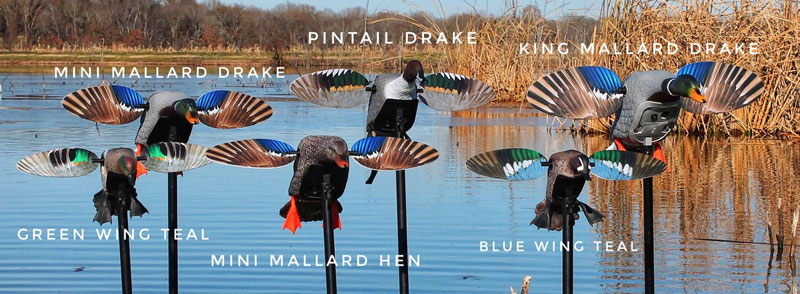
The gentleman brought the “fan” with him because of something he’d seen in the strawberry fields near his home in the Sacramento Valley. When the weather got too cold, too early, the white fans were put out to keep air moving and keep frost off the berries. But when they were turned on, piles of ducks would start locking up and coming to the fields. It defied logic, but apparently, the strobe of the spinning “wings” was visible from a long distance, and to the ducks, it looked like more ducks.
Simmons got with a friend, Murray Crowe, a builder who could tinker with just about anything, to build some spinning wings on a regular decoy body. The decoys they built worked, but they needed some more help. Crowe involved Terry Denmon, an engineer and avid duck hunter, to put the new, spinning-wing decoy into production. The first year, the goal was making and selling 7,500; they made and sold 15,000. They soon discovered the key to success was in getting the motor to spin the duck wings at just the right RPM. Other improvements have kept the decoys improving in looks and performance every year. The rest, as they say, is history.
Mojo TV helps Denmon continue living the dream
From being past chairman of the Louisiana Wildlife and Fisheries Commission to spending a lifetime hunting everything from ducks in the swamp to exotic animals all over the world to running one of the most-successful outdoor companies in the country, Terry Denmon is living the dream.
Part of that dream was also his induction into the Legends of the Outdoors Hall of Fame.
And there’s more. Denmon continues to serve as host of the popular Mojo TV show, now in its 12th season. You can watch Mojo TV on the Sportsman’s Channel; past seasons and episodes are available on YouTube.
“One of the things we do is always take somebody hunting with us that wouldn’t ordinarily have the opportunity to go on hunts like we feature. We go from our own backyard to almost anywhere in the world.”
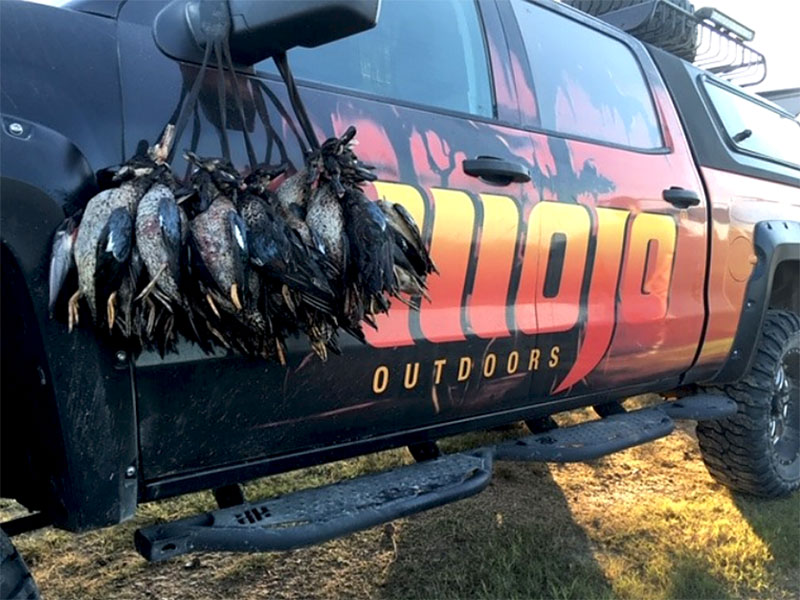
Denmon saids it’s a teaching tool, too. If they can help people be more successful outdoors, that’s a plus. But if they do something that doesn’t work, they share that as well.
Smile hunters; It’s Spoonzilla
It started as a well-executed joke played on Terry Denmon during a Mexican duck hunt and ended up going viral. Hunters, meet “Spoonzilla.”
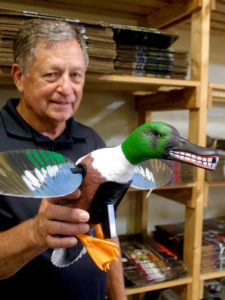
“Some of the guys we hunt with love to shoot spoonbills, but I always tell them I’m a refined trophy duck hunter. I go after mallards,” Denmon said.
The late Mike Morgan, former host of Mojo Outdoors TV, and Ramsey Russell, founder of getducks.com, got with renowned decoy carver Jason Chuley to make a hand-carved, spinning-wing spoonbill decoy — “Smiley” — and presented it to Denmon.
It turned out to be a good joke, but an even better seller.
The group took pictures of Spoonzilla and posted them on social media. It went viral. Orders piled up before they even got home and figured out how to produce them. Mojo made 4,500 spoonbills the first year and sold every one in two weeks. The same thing happened this year.
It’s not the only venture into daffy ducks for Mojo, which is currently working on another pair of novelty ducks; Denmon just got the prototypes and isn’t sure what they will do with them at this point.
Then, there’s last year’s “Sir Coot”, a novelty for Ducks Unlimited banquets around the country. It sold out, too. Coots, aka “pouldeau” in Louisiana — are generally considered at the bottom of the pecking order of waterfowl. But not “Sir Coot” — also carved by Chuley — dressed in a tuxedo and top hat.
 As Denmon said, “Hey, duck hunters have to have fun too, right?”
As Denmon said, “Hey, duck hunters have to have fun too, right?”


